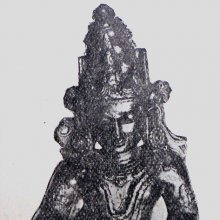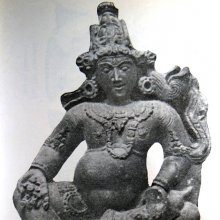Subhadra, Subhadrā, Su-bhadra: 45 definitions
Introduction:
Subhadra means something in Buddhism, Pali, Hinduism, Sanskrit, Jainism, Prakrit, the history of ancient India, biology. If you want to know the exact meaning, history, etymology or English translation of this term then check out the descriptions on this page. Add your comment or reference to a book if you want to contribute to this summary article.
Subhadra has 45 English definitions available.
Images (photo gallery)
Languages of India and abroad
Sanskrit dictionary
[Deutsch Wörterbuch]
Source: Cologne Digital Sanskrit Dictionaries: Böhtlingk and Roth Grosses Petersburger WörterbuchSubhadra (सुभद्र):—
1) adj. (f. ā) prächtig, herrlich: subhadramarya.bhojanaṃ bibharṣi [Ṛgveda 8, 1, 34.] saṃvid [10, 10, 4.] mahodadhi [Mahābhārata 1, 8420] (samudra v. l. bei [Nīlakaṇṭha]). śravas adj. [Bhāgavatapurāṇa 2, 4, 15. fg.] kathā [3, 13, 47.] bhagavato rūpam [4, 8, 52.] mukha [11, 26, 20.] — subhadramusta [Ṛtusaṃhāra 1, 17] werthlose v. l. für sabhadramusta . —
2) m. a) Azadirachta indica Juss. (nimba) [AUSH. 78.] — b) ein N. Viṣṇu’s [Hemacandra’s Abhidhānacintāmaṇi 64.] [Śabdamālā im Śabdakalpadruma] — c) wohl Beiname Sanatkumāra’s [PAÑCAR. 1, 3, 83. 4, 13. fgg. 15, 22.] — d) Nomen proprium α) eines Sohnes des Vasudeva [Bhāgavatapurāṇa 9, 24, 46.] — β) eines Sohnes des Kṛṣṇa [Bhāgavatapurāṇa 10, 61, 17.] — γ) eines Sohnes des Idhmajihva [Bhāgavatapurāṇa 5, 20, 2. 3.] — δ) des letzten von Śākyamuni zum Buddhismus bekehrten Mannes [BURNOUF, Intr. 78. 173.] [Lot. de Lassen’s Anthologie b. l. 335.] [Lebensbeschreibung Śākyamuni’s 292 (62).] [Hiouen-Thsang 1, 337.] — ε) eines Berges [PAÑCAR. 1, 10, 40.] —
3) f. ā a) Bez. verschiedener Pflanzen: Ichnocarpus frutescens [Ratnamālā 27.] Curcuma Zedoaria [Rājanirghaṇṭa 6, 230.] Prosopis spicigera [8, 33.] Gmelina arborea [9, 35.] = śyāmālatā [Śabdamālā im Śabdakalpadruma] = ghṛtamaṇḍā [Śabdacandrikā] ebend. — b) eine Form der Dākṣāyaṇī [Oxforder Handschriften 39,b,25.] — c) Nomen proprium α) einer jungeren Schwester Kṛṣṇa’s und Gattin Arjuna's [Mahābhārata 1, 2273. fg. 2449. 3830. 7919. fgg. 7, 1533. 2501.] [Harivaṃśa 1954. 7708.] [WEBER, KṚṢṆAJ. 288.] [Bhāgavatapurāṇa 1, 10, 9. 13, 4. 9, 22, 32. 24, 54.] [Pāṇini’s acht Bücher 4, 2, 56, Scholiast] pūrvaja Bez. Kṛṣṇa’s [PAÑCAR. 4, 1, 31.] haraṇa [Harivaṃśa 8396.] — β) einer der vielen Gattinnen Durgama's [Mārkāṇḍeyapurāṇa 75, 45.] — γ) einer Tochter Balin's und Gattin Avīkṣita’s [Mārkāṇḍeyapurāṇa 123, 16.] — δ) einer Enkelin Rukmin's und Gattin Aniruddha's [Viṣṇupurāṇa 4, 15, 21.] — ε) einer Tochter des Asura Sumāya [Kathāsaritsāgara 45, 333.] — ζ) einer mythischen Kuh [Mahābhārata 5, 3610.] —
4) n. a) Heil (vgl. bhadra): subhadraṃ te [Bhāgavatapurāṇa 4, 12, 23.] — b) Nomen proprium α) eines Catvara [Mahābhārata 8, 2031.] — β) eines von Subhadra beherrschten Varṣa im Plakṣadvīpa [Bhāgavatapurāṇa 5, 20, 3.] — Vgl. saubhadra .
Sanskrit, also spelled संस्कृतम् (saṃskṛtam), is an ancient language of India commonly seen as the grandmother of the Indo-European language family (even English!). Closely allied with Prakrit and Pali, Sanskrit is more exhaustive in both grammar and terms and has the most extensive collection of literature in the world, greatly surpassing its sister-languages Greek and Latin.
See also (Relevant definitions)
Partial matches: Bhadra, Cu, Shu.
Starts with: Subhadradhanamjaya, Subhadradhananjaya, Subhadraharana, Subhadraharanaparva, Subhadraka, Subhadrakatha, Subhadrani, Subhadraparinaya, Subhadrapurvaja, Subhadrate, Subhadravijaya.
Ends with: Vasubhadra.
Full-text (+87): Saubhadra, Subhadda, Abhimanyu, Saubhadreya, Subhadresha, Subhadraparinaya, Subhadradhanamjaya, Subhadrapurvaja, Subhadraharana, Lampaka, Subhadravijaya, Vajrabhadra, Subhadrate, Kalinga, Shyamadevi, Yavasa, Shonasangama, Shriprabha, Abhiramavarta, Svabhadra.
Relevant text
Search found 82 books and stories containing Subhadra, Subhadrā, Su-bhadra, Su-bhadrā; (plurals include: Subhadras, Subhadrās, bhadras, bhadrās). You can also click to the full overview containing English textual excerpts. Below are direct links for the most relevant articles:
Maha Prajnaparamita Sastra (by Gelongma Karma Migme Chödrön)
Jātaka of the deer who sacrificed himself < [Part 1 - Mahāyānist list of the eighteen special attributes of the Buddha]
Part 5 - Pañcamātra Bhikṣusahasra (section of five thousand arhats) < [Chapter VI - The Great Bhikṣu Saṃgha]
Appendix 3 - Suicide in Buddhism (ātmavadha) < [Chapter XX - The Virtue of Generosity and Generosity of the Dharma]
The Agni Purana (by N. Gangadharan)
Chapter 94 - Mode of placing the stone slabs (śilā-vinyāsa)
Chapter 265 - The sacred bathing of the deities (dikpāla-snāna)
Chapter 298 - The treatment for the poison due to snakes such as the Gonasa
Puranic encyclopaedia (by Vettam Mani)
The Padma Purana (by N.A. Deshpande)
Chapter 18 - The Greatness of Puruṣottama < [Section 7 - Kriyāyogasāra-Khaṇḍa (Section on Essence of Yoga by Works)]
Chapter 169 - Varāha-tīrtha < [Section 6 - Uttara-Khaṇḍa (Concluding Section)]
One hundred and eight (108) names of Sāvitrī < [Section 1 - Sṛṣṭi-khaṇḍa (section on creation)]
Rig Veda (translation and commentary) (by H. H. Wilson)
Shrimad Bhagavad-gita (by Narayana Gosvami)
Verses 1.4-6 < [Chapter 1 - Sainya-Darśana (Observing the Armies)]
Verses 1.17-18 < [Chapter 1 - Sainya-Darśana (Observing the Armies)]
Related products






